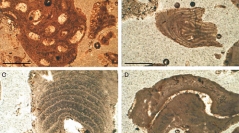

 Geodiversitas
34 (1) - Pages 61-76
Geodiversitas
34 (1) - Pages 61-76This contribution discusses current carbonate deposition in the channel between the Ponza and Palmarola islands and along the western coast of Palmarola, focusing on the quantitative contribution of biogenic carbonate and in particular on the production and accumulation of carbonates by coralline algae. Seventeen out of 150 grab samples have been selected as representative of the main sedimentary features facies of the seafloor between 30 and 100 m of water depth (wd). They were analyzed using XRD and EDTA titration. Thin sections of the same samples were made to identify their biogenic components and to quantify the contribution of calcareous algae to the total sediment. Maximum carbonate production takes place between 40 and 70 m wd, with the percentage of carbonates ranging between 83.1 and 95.7%. of the total. Multidimensional statistical analyses found two different carbonate facies: the coralline algae facies (CA) occupies 38 km2 between 30 and 70 m wd, and the carbonate matrix facies (CM) covers 24 km2 between 70 and 100 m wd. An estimate of the current contribution of algal carbonates to seafloor sediments is about 80% in the CA facies and 15% in the CM facies. The accumulation of total carbonate sediments in the uppermost 2 cm interval of the CA facies is calculated to be 20 566 g m-2 and the fraction of coralline carbonate in the superficial 2-cm layer of the CM facies is calculated as 16 452 g m-2. The production rate of the mean 7% live coralline covers ranges between 7.91 and 31.64 g m-2 yr-1.
Îles Pontines occidentales, mer Tyrrhénienne, minéralogie du carbonate, algues rouges calcifiantes, accumulation de carbonate, taux de production de carbonate algal